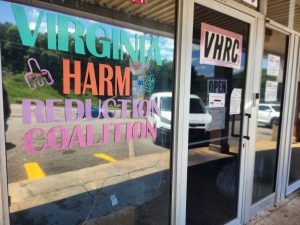Two women are leading the charge to create a cooling center to serve the homeless population in Henry County and Martinsville. Ariel Johnson, who is director of the MHC Warming Center, and warming center volunteer Nancy McMillian.

Johnson explained the warming center exists for colder months, but after March, the weather starts to heat up. But during warmer months like June, July, and August, this becomes a health hazard due to the risk of heat stroke, heat exhaustion, and sun poisoning.
“They sleep in that (heat), they do everything in that,” said Johnson, who added that homeless people visit the Harm Reduction Center just to cool off.
McMillian takes food and supplies to homeless individuals throughout the week.
“They won’t let them go into the library, they don’t have anywhere to go, and we don’t have the cooling places for them,” she said, adding that the stigma around homeless individuals keeps them from finding places to stay cool or warm up in the summer.
“They don’t bite, they are some of the sweetest individuals,” said McMillian, who works at the warming shelter but noted there are limitations on when it can open. For now, the warmer months aren’t part of its schedule.
With the current local housing crisis, the number of individuals who are considered homeless has risen. The World Population Review currently states that there are 6,529 homeless individuals living in Virginia, and the Collinsville area has seen an influx of homeless individuals in recent years.
With summer bringing blistering heat, many homeless individuals, as well as individuals who work with them, are asking for a cooling shelter to help combat heat-related illnesses.
Bobby Morton, one of the men that McMillian regularly supports, has had issues with the summer weather.
“I’ve already had a heat stroke. Everyone needs a place to keep cool during the summer,” Morton said, urging the community to look out for the homeless population.
Adam Willard, another man affected by homelessness, said that he became homeless after a divorce.
He says a cooling shelter is needed to help mitigate heat-related health issues. In the meantime, he’s doing what he can to keep himself and others cool.
“I have a cooler that I try to keep ice in for anybody that comes by. We even give out rags to help them stay cool,” he said, adding “one of the ways we keep our tent cool is to put it up on pallets. It’s like an underpinning under a trailer, which helps keep it cool.”
The area’s homeless set-up a camp at what they refer to as the “swamp,” Willard said, adding that even though the area stays cool, it’s teeming with mosquitoes and is plagued by areas where chemicals were dumped in the water.
“Right where the shelter is built, there are a bunch of 55-gallon barrels under the ground,” he said. “If you don’t mark where they are at, you will drop waist deep into sludge.”
He said that he doesn’t know what the chemicals are, but the area has trouble keeping fish and that there is a strange film on the water.
“When it would rain, the water would get fresh, the fish would come in and feed, but then they would leave,” he added.
The water has caused several individuals’ wounds to get infected, and it’s not a safe environment to live in.
“I can stay warm, but you can only take so many clothes off. It’s a whole lot harder to stay warm than stay cool,” he said, adding that even when it is open, the warming shelter also has a few issues.
“They don’t count the windchill, only the stationary temperature,” he said. Still, there are more ways to stay warm in winter than there are to stay cool in the summer.
“What we need is at least somewhere to cool down or warm up for a bit, maybe get a hot cup of coffee, then go back to our camp,” he said.





